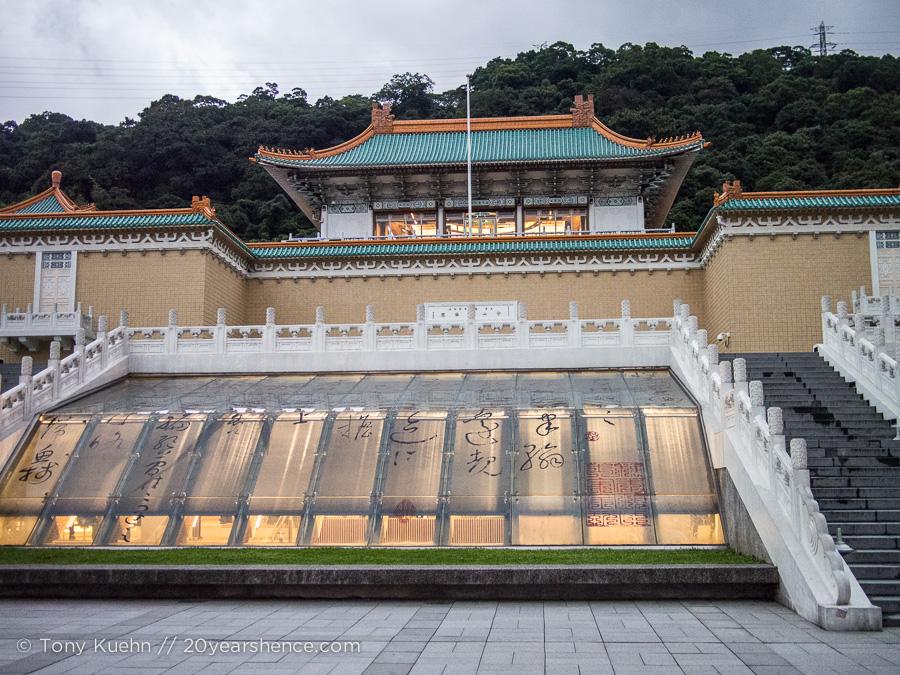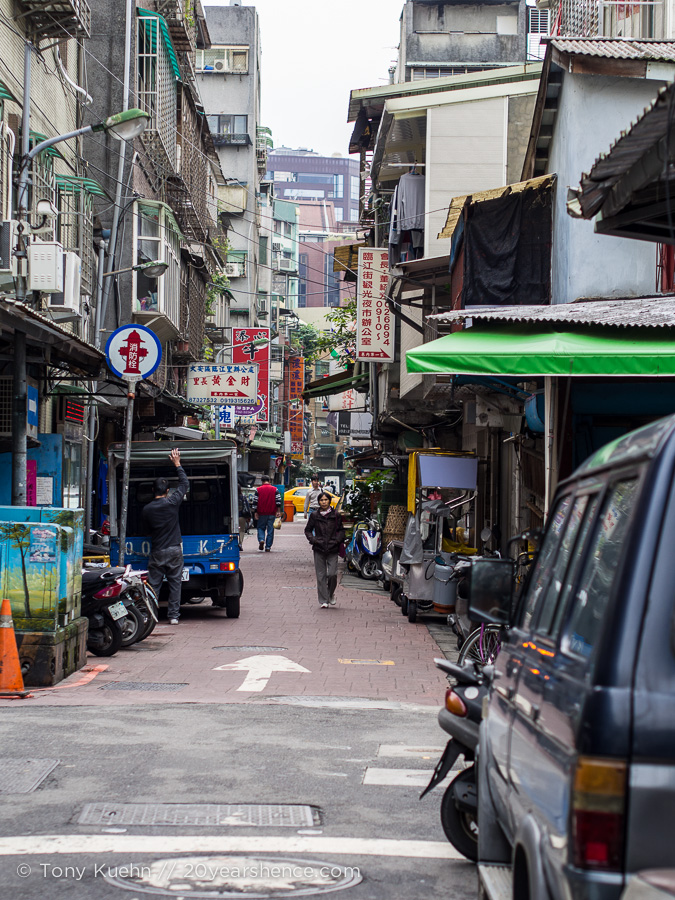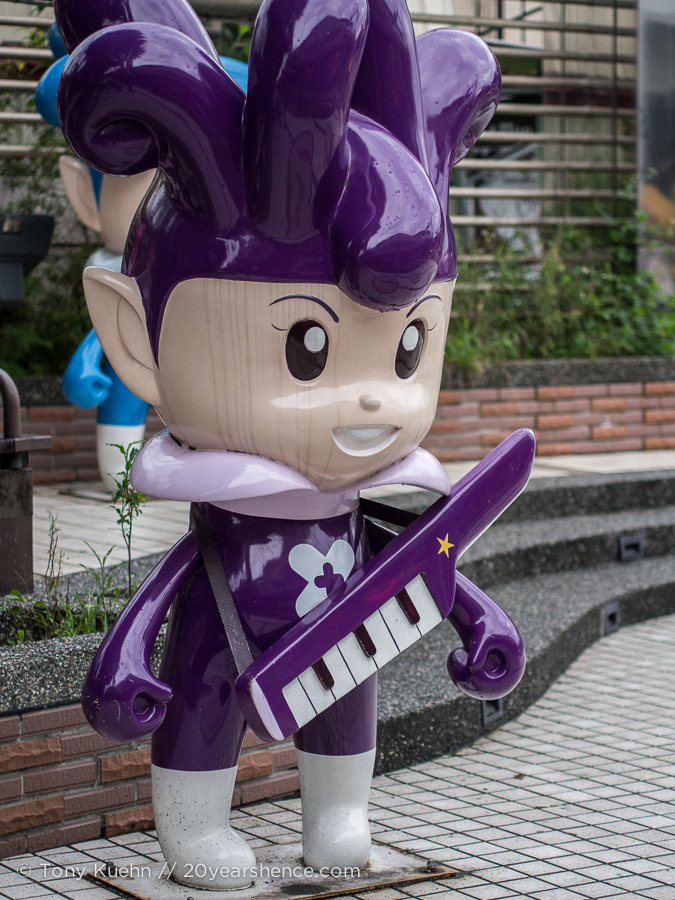The end of November in Taipei is gray, cold and rainy. Winter monsoons sweep across lower Asia and blanket Taiwan’s north coast in a haze of low clouds and nearly perpetual drizzle. Despite this, Taipei bustles.
No one leaves their home without an oversized poncho and the street markets are a sea of umbrellas and canvas awnings. During moments when the rain abates the streets are choked with people rushing to get their business done before the rain begins anew.
After two months of sun and stifling heat in the Philippines, we are ready for the crisp air and cooling rains of Taipei. Eventually, blinking rain out of our eyes and constantly wiping water spots off our glasses begins to grow tiresome, but Taipei is a magnet that draws us out of our room day after day, and only rarely are the rains too strong to dampen our enthusiasm for the endless variety of the city streets.
The roads are awash with scooters, zipping through the rain with the ordered chaos of Asian traffic we’ve grown to appreciate over the last few months. Horns rarely honk here, as the unwritten rules of the road are known and understood. Drivers do what they need to in order to make it to their destination, aided by a kind of quid pro quo that seems inviolate. If someone needs to make a quick right or drive the wrong way for a little while, it’s allowed because, well, eventually everyone will have to do something wacky and it’s just easier if everyone can go about his or her business without fuss. It’s collectivism at its finest.
Overhead, the metro rumbles its way across the city, trundling between buildings, scribing a lazy loop around the city. People rush up the stairs around us as trains approach and others look out tentatively from the awnings below, waiting for a break in the rain, or a traffic light to change. The world’s second tallest building, Taipei 101, can be seen from various points along the metro route, and it towers like a jade obelisk, visible from much of the city. Meant to look like a stalk of bamboo, to our western eyes the colossal blue-green tower appears more like a stack of Chinese takeout containers. Taipei 101’s quirky design is not an anomaly, and the downtown is filled with a mixture of new and old buildings, some starkly modern and many eccentric, with more appearing every day. The elevated portion of Taipei’s metro offers us a nice chance to observe some of the more interesting buildings on a footing more suited to their height.
All along the streets below are little shops, some selling the ubiquitous bubble tea (it was invented in Taiwan, after all), others hawking goods and still more selling sundry food items. Cauldrons of tofu bubble away next to pots of noodles, broth, seafood and nearly anything else you can imagine. As we alight and descend the stairs to transfer to the underground metro, everywhere we turn there is food on offer, and delicious smells arrest us as we dodge scooters and other pedestrians.
We make the short walk from the eponymous metro station to the Sun Yat-sen (SYS) Memorial hall, which occupies a large park and looms low over the surrounding landscape. We can see Taipei 101 in the distance, peeking over the yellow tile roof. Every hour a very serious (but slightly comical) changing of the guards takes place, under the solemn watch of a giant statue of Sun Yat-sen. It’s a big draw for tourists, but the charm of the SYS Memorial Hall lies in the area surrounding the building. Statues of a very jaunty Sun Yat-sen are surrounded by fountains, benches and greenery, and the surrounding skyline makes a dramatic background for the gardens.
The complex containing the National Concert Hall and National Theater is a few metro stops away from the SYS Memorial Hall, and we make the journey as the sun sinks below the horizon. We had heard that the area is beautiful at night, and it doesn’t disappoint. Behind the monolithic performing arts buildings is the Chiang Kai-shek (CKS) Memorial Hall. The park and memorial are tastefully done, and arriving at night has the added bonus of allowing us to watch students practice complex dance routines in the arcades and under the walkways of the National Concert Hall and Theater. The buildings are beautifully lit, and seem to be made for night-time enjoyment. The glow of the city turns the sky a light greenish-pink and provides an eerie backdrop for the CKS Memorial. The memorial is reminiscent of the Temple of Heaven in Beijing and it dominates the surrounding parade grounds.
Monuments and skyscrapers aside, Taipei’s landscape is dominated by another phenomenon: kerai. Kerai (“cute”) is everywhere: on buildings, signs, clothing and scooters. Nothing in Taipei is complete without some sort of wide-eyed mascot, clothed in vivid hues and smiling welcomingly. It reminds us of Japan, one-time occupier and oppressor of Taiwan, but somehow feels more open, as though all the cuteness really does embody the Taiwanese spirit. Nowhere else have we encountered such aggressively friendly people, for lack of a better phrase. Courtesy, helpfulness and a genuine interest in those around them exemplify the Taiwanese. If you look momentarily lost or confused, be assured that someone will swoop in and do everything they can to help. On our way to the National Palace Museum, simply reading the sign for the bus lines is enough to elicit detailed help from several strangers, one of whom insists that they wait with us in order to show us the correct bus when it arrives.
Once at the museum, we are efficiently ushered through halls containing some of the most stunning Chinese and traditional Taiwanese works of art we have ever seen. Complex carvings, immense scrolls and screens, metalwork, pottery; essentially any media imaginable was on display. Much of what is in the museum was smuggled out of China during the Cultural Revolution in the late ’40s, when a sea of Chinese exiles escaped to Taiwan to begin their lives anew. Sadly, photography is not allowed inside the museum, but the works are among the best in the world, and our visit lasts hours and is fascinating. Interestingly, the biggest draws for Asian tourists are the stone carving that looks just like a piece of meat and a detailed jade carving of a grasshopper on a cabbage. We wait in line to seem them, wondering if they will live up to the hype. We leave, bemused that these things could overshadow the other spectacular works in the rest of the sumptuous museum.

Back on the streets, we realize that much of Taipei has a certain smell: a mixture of steamed buns, tofu, and an ineffable blend of Chinese spices that pervades public spaces. This smell comingles with the metallic tang of exhaust, wet concrete and burning joss sticks to create a scent that reminds me of grandma’s house, assuming grandma was a wizened Taiwanese woman that ran a Chinese bakery next to a temple on a busy street. It’s comforting, in an odd way.
Taipei is a huge, diverse city that has nearly everything an urban explorer could want: transit, great food, culture, history, art and friendly people. Though the city is almost always buzzing, that frenetic energy never feels overwhelming. There is something to look at around every corner, and someone to talk to at every street stall and in every restaurant. It’s a great city, an amazing sensory experience and a destination that is not to be missed.


Huh. I had no idea what to expect from your reports on Taipei. Very cool!
It ranks pretty high on our list of cool cities. In fact, Taiwan in general doesn’t get nearly as much love as we think it should. It has made the very, very short list of “places we would happily live.”
You’re doing a great sales pitch for Taiwan, I’d heard great things but had no idea Taipei was so lovely to look at. Gorgeous photos as always.
Thanks so much! When we love a place we don’t hesitate to endorse it! If you think these photos are nice (and thanks for thinking so) wait a tick, we haven’t even gotten to the best stuff yet!
I cannot wait to visit Taipei! I’ve heard it represents the absolute best of Chinese culture and this post reinforces that idea. Love the photos!
I would certainly agree with that statement, though I would happily extend it to all of Taiwan. If you go to Taiwan, do yourself a favor and budget enough time to see the rest of the country, not just Taipei. Our upcoming posts will show that we really believe that it is a fantastic place, and while it may be the best of China, it’s also very unlike China in all the most important ways (in our opinion), which makes it one of our favorite places!
Did you just mention bubble tea? I wish I could have one right now to kill the heat and refresh myself.
Surprisingly, Taipei was the highlight of our Taiwanese trip. We didn’t realized it was so full of art everywhere and had such a great urban culture. I agree with you that Taipei is not to be missed! 🙂
Oh bubble tea! They have it in Bangkok (and even Phnom Penh), and I get it whenever I can. Nothing has come close to the level of deliciousness that Taiwanese bubble tea achieved though. I do miss it, so very much. It’s a shame the four of us never got to run around the streets of Taipei together, maybe one day!
Looks like a great city to explore. I still haven’t tried bubble tea, despite the fact new shops selling it pop up every minute here in Phnom Penh. What’s it all about? It sounds weird, and I am a bit scared trying it. Having lived in the UK for 8 years it feels like sacrilege. 🙂
Oh, you should try it! Asians know their way around tea, that’s for sure! I can’t guarantee that you will love it, since everyone we talk to is either very for or very against the stuff. It seems to be a textural thing, the tapioca pearls are either great fun or very unnerving for people.
Essentially, bubble tea is a tea-based drink of your choice, either green or black tea mixed with milk, fruit juice or chocolate (the variety can be endless). It’s all poured over the “bubbles” which are really tapioca spheres, though you can also get QQ, which is a fruit jelly, or other types of jellies. You suck it all up through a jumbo straw, it’s great fun! Start with a bubble milk tea and branch out from there. Good luck!
Love the special smell that you mentioned. It’s so true, although your portrayal is much kinder than ours 🙂 Great photos. I love CKS Memorial at sunset, when you can see the teenagers practicing their dance moves and the lights turning on. Great job capturing it!
Thanks so much! A big part of why the smell worked for us was because so much of it was food-related! CKS and the National Theater area is a lot of fun after dark for sure! Those kids have skillz!
The temples in Taipei look amazing at night. So much like the Forbidden city in Beijing! Love these snapshots and I hope to make it there soon :):)
They sure do! Like the Forbidden City, only better in our opinion! Check out our post on the top three temples in Taipei (https://www.20yearshence.com/taipei-top-3-temples/) for our nighttime temple shots! Taipei is a can’t miss for this part of the world, that’s for sure!
It’s nice to see night shots of these famous Taipei sites. I went to these spots at day time and I love how they looked like with the lights at night 😀